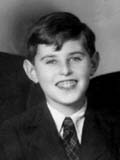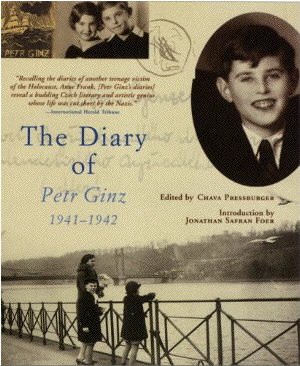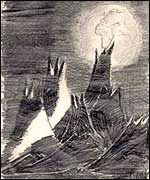.

A
New Life For Youth's Wartime Diaries
Czechs honor artist who died at
Auschwitz
By
Ladka M. Bauerova
International Herald Tribune
January 27, 2005
More than 60 years
after Petr Ginz died in a gas chamber at
Auschwitz, the Czech Republic is finally paying
homage to the brilliant teenager by publishing his
recently found diaries.
Recalling the
diaries of another teenage victim of the
Holocaust, Anne Frank, they reveal a budding Czech
literary and artistic genius whose life was cut
short by the Nazis.
The diaries -
actually a collection of diary entries, poems,
short stories and drawings - offer keen insights
into the reality of everyday life of Jews in
wartime Prague. Oddly, they might have been lost
forever if not for the Columbia space shuttle
disaster two years ago.
For decades
after World War II, the name Petr Ginz was known
only in Israel. Scraps of diaries, a few short
stories and some drawings and linocuts stored in
the archives of the Yad Vashem memorial in
Jerusalem were all that was thought to remain of
the boy's extraordinarily prolific output.
Then the shuttle
exploded over Texas on Feb. 1, 2003, killing all
seven astronauts aboard. Among them was Colonel
Ilan Ramon, the first Israeli citizen to travel
into space.
Shortly before
Columbia's takeoff, Ramon, a son of an Auschwitz
survivor, asked Yad Vashem to pick an item he
could take with him to honor the victims of the
Holocaust. The museum sent a copy of "Moon
Landscape," a linoprint Ginz made just before he
was transported to the Czechoslovak concentration
camp at Theresienstadt in August 1942. The picture
represented the 14-year-old's vision of what our
planet might look like from the moon.
In the aftermath
of the Columbia tragedy, the drawing became so
well known that Ginz's name was cited even by
President George W. Bush. The coverage eventually
inspired a resident of Prague, Jiri Ruzicka, to
take another look at a box of six yellowed
notebooks and some papers he had found in the
attic of the house in which he had been living for
50 years. The box's contents turned out to belong
to the artist who had created "Moon Landscape."
Ruzicka
contacted Yad Vashem and offered to sell the
material. After several rounds of negotiations,
the museum and Chava Pressburger, Ginz's surviving
sister, managed to acquire the notebooks and
papers, which included the diary, an unfinished
novel, several short stories, drawings and prints.
"When I saw the
diary I was terribly shocked," said Pressburger,
who now lives near the Israeli city of Beersheba.
"Of course I remember all those events very
clearly." Born Eva Ginzova, Pressburger grew up in
Prague idolizing her brother, who was 2 years her
senior. Like Petr, she was sent to Theresienstadt,
where she managed to save some of her brother's
notes after the Nazis transported him to
Auschwitz.
During and
immediately after the war, Eva's parents stored
much of their dead son's writing and art in the
house of a family friend. Eva fled Czechoslovakia
after the 1948 Communist putsch, unaware of the
existence of the notebooks. She ended up in Israel
with only few pages of her brother's notes and a
science fiction novel. Her parents, who followed
seven years later, never told her about the
hideout. Meanwhile, the family friend died and the
house was eventually purchased by Ruzicka.
"He told me that
he often thought of throwing the papers away,"
Pressburger said in a telephone interview. "He
threw out so much other old stuff from the attic.
But for some reason he always decided to hold on
to Petr's papers."
Pressburger
decided to publish "My Brother's Diary" in the
Czech Republic, where Petr remained largely
unknown. That is about to change. Earlier this
month, the Czech Postal Service issued a
commemorative stamp bearing the boy's photo and
his famous drawing. On Feb. 8, Pressburger will be
in Prague to launch the published diaries.
While describing
a "ghetto without walls" - the increasing number
of rules, prohibitions and humiliations Jews were
subjected to in Prague - the writing also reveals
a teenager with a sly sense of humor. In the first
entry, dated Sept. 19, 1941, the author writes,
"It's foggy today. They just introduced a special
sign for Jews" - a drawing of a Star of David
follows. "On the way to school I counted 69
'sheriffs,"' he adds, referring to people wearing
the star. A few pages later, Ginz recounts the
woes of Prague Jews in a long, ironic poem.
|

|
.
|
By all accounts,
Petr Ginz was an extraordinary child. According to
his sister, in addition to the diaries, he had
written eight novels and countless short stories
by the age of 14. The surviving diary entries from
Theresienstadt, where he spent the last two years
of his life, reveal a restless genius.
With limited
access to the camp's library of books confiscated
from the prisoners, he read everything he could.
He studied history, drew maps, learned English and
worked on his own Czech-Esperanto dictionary. He
made up a secret alphabet to record sensitive
information, such as the place in his coat lining
where his parents had hidden extra money, or how
his aunt warned him to avoid "bad" girls.
His aptitude for
drawing earned him a job in a workshop where he
worked on Nazi propaganda leaflets while creating
his own art whenever he had the time.
Most
importantly, Ginz became the driving force behind
the secret Theresienstadt newspaper Vedem (We Are
Leading), which was published by the boys in his
barracks. Written by hand and read out loud every
Friday evening, the newspaper consisted of essays,
poems and short stories, as well as a weekly
column, "Strolls Through Theresienstadt," in which
Ginz and his friends reported on various parts of
the camp, from the bakery to the morgue. The
newspapers have survived and are part of the
Theresienstadt Memorial collection.
"Petr was
universally admired," said Jiri Kotoue, a friend
of Ginz's from Theresienstadt who survived the
subsequent transport to Auschwitz. "Everybody
looked up to him. He was just a terrific boy with
enormous talent and an insatiable appetite for
learning anything there was to be learned."
Petr Ginz was
not allowed to fulfill his potential. On Sept. 28,
1944, he was put on a train for Auschwitz and sent
to his death in a gas chamber immediately upon his
arrival. He was 16.
Sixty-one years
later, his sister hopes to keep his spirit alive
by publishing the newfound diaries.
"There is enough
Holocaust literature describing the horror,"
Pressburger said. "I don't really need to add
anything to that. But Petr's diaries show that if
you were a child during the Holocaust you could
still live moments of simple happiness. You could
be adventurous in your mind."


